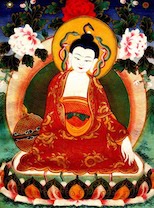Koso Wasan 7
The ocean of birth-and-death, of painful existence, has no bound;
Only by the ship of Amida's universal Vow
Can we, who have long been drowning,
Unfailingly be brought across it.
Who is Amida Buddha?

People whose view of life is built upon a foundation that is outside the purview of the Buddha Dharma find the figure of Amida Buddha - the Buddha of immeasurable light (amitabha) - almost impossible to contemplate. Amida seems to be so like a deity - the kind of entity that Judaeo-Hellenistic (European) culture describes as 'God'.
Confusing the issue is the question of whether it is legitimate to use words like 'saviour' and 'person' in the context of the Buddha Dharma. Is the use of these terms strictly correct?
If we take Shakyamuni as an example, then we only need to consider for a moment how we would have encountered him if we were one of his disciples during his time on earth. Of course, his relationship with us would have been as a person, and not a mere abstraction; neither is Amida Buddha just an impersonal force. Shakyamuni's teaching was directed at freeing us from suffering; what better word can describe this than 'salvation'?
From the perspective of the Buddha Dharma, gods of all kinds are individual beings within samsara, and within the realm of desire (Sk., kama-dhatu); a species of intelligent life that deserves the respect due to all sentient beings. By contrast, Buddhas - as dharma body as suchness - completely transcend samsara and enter it of their own volition - as dharma body as compassionate means - to teach the dharma.1
Inconceivable light (wisdom-compassion) is Amida Buddha's 'personal' attribute because it is derived from that Buddha's unique Vows. Just as Shakyamuni Buddha's physical presence made the dharma accessible to his disciples in kama-dhatu, so Amida Buddha's manifest presence, the Name, calls to all beings within the six realms of samsara, including kama-dhatu, to entrust themselves. And the power of Amida Buddha's Primal Vow 'saves' us, by freeing us from the thrall of samsara.
Can the entity known as Amida can be seen as supporting a more sophisticated and subtle idea of the deity in European religion? Does it match ideas of divinity that can be found in the writings of great theologians like Basil, Anselm, Michael Psellus or Eckhart von Hochheim? In my view, not at all. Furthermore, such comparisons demean and deface both broad traditions.
Each religion is equally noble but discontinuous; each has its own profound philosophy and patterns of thought and experience. Differences may be subtle, but they are also often important. Comparisons, it seems to me, will be ultimately futile. We do better to respect the uniqueness of each. Even though it is possible to use similar terminology in each case, the arena of endeavour and the questions they address are not exactly the same.
In the Larger Sutra, Shakyamuni suggests that his primary goal was to reveal the dharma of Amida Buddha so that future generations may accept shinjin of the Primal Vow. He also concludes his discourse by saying that the Larger Sutra will endure, while all other Buddhist teachings will disappear over time. As things developed in the Mahayana, Amida Buddha and his two attendant bodhisattvas became the principal refuge of most followers of the Buddha Dharma; Shakyamuni began to fade from view. In Jodo Shinshu, Amida Buddha - in the form of his Name, Namo Amida Butsu - stands absolutely alone, and is our only refuge.
At the time that Nagarjuna Bodhisattva was writing, appreciation of Amida was growing. Nagarjuna, in fact, was a very important proponent of Amida and gave significant emphasis to him in his writing. In the verse which inspired this wasan of Shinran, Nagarjuna gives a most moving and intimate description of Amida:
Carried on the ship of the Eightfold Path,
One crosses the ocean difficult to cross.
One crosses oneself and also ferries others across;
For this reason I worship Amida, the one freely working.2
In this verse we discover the seminal concept of Amida which inspires this verse. It is the concept to which Shinran subscribes. Nagarjuna tells us that Amida is active: he boards the boat of the Noble Eightfold Path (the dharma), crosses the sea of birth-and-death, and, then ferries us across. At first glance it sounds rather as though it is being suggested that Amida is in the boat with us but, in fact, he has become the boat which carries us across.
Shinran sees the boat as a metaphor, which points to the Primal Vow of Amida Buddha. The boat is the symbol of the reality, which is Amida Buddha's Primal Vow. Nagarjuna's analogy illustrates that Amida is the dharma in action. Indeed, the Name (Namo Amida Butsu) itself is living and active.
1: Dharma-body as compassionate means may take form as an apparitional body in the physical realm (nirmanakaya) or as a fulfilled body (sambhogakaya). Amida Buddha is a fulfilled body.
2: CWS, p. 24.